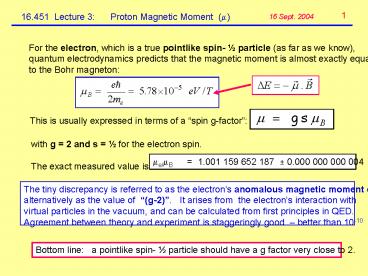16'451 Lecture 3: Proton Magnetic Moment - PowerPoint PPT Presentation
1 / 10
Title:
16'451 Lecture 3: Proton Magnetic Moment
Description:
to the Bohr magneton: This is usually expressed in terms of a 'spin g-factor' ... magneton, N: that is, we expect: with g = 2 and s = for the proton spin. ... – PowerPoint PPT presentation
Number of Views:55
Avg rating:3.0/5.0
Title: 16'451 Lecture 3: Proton Magnetic Moment
1
1
16.451 Lecture 3 Proton Magnetic Moment
(?)
16 Sept. 2004
For the electron, which is a true pointlike spin-
½ particle (as far as we know), quantum
electrodynamics predicts that the magnetic moment
is almost exactly equal to the Bohr magneton
This is usually expressed in terms of a spin
g-factor
with g 2 and s ½ for the electron spin.
The exact measured value is
?e/?B 1.001 159 652 187 ? 0.000 000 000
004
The tiny discrepancy is referred to as the
electrons anomalous magnetic moment or
alternatively as the value of (g-2). It
arises from the electrons interaction
with virtual particles in the vacuum, and can be
calculated from first principles in
QED. Agreement between theory and experiment is
staggeringly good better than 10-10
Bottom line a pointlike spin- ½ particle
should have a g factor very close to 2.
2
Now for the proton
2
By analogy, a pointlike proton should have a
magnetic moment given by the nuclear magneton, ?N
that is, we expect
with g 2 and s ½ for the proton spin. The
exact measured value is which implies a
g-factor of about 5.586 --- a huge discrepancy
with the prediction for a pointlike object...
?p/?N 2.792847337 ? 0.000000029
Conclusion the proton must have an internal
structure that accounts for its magnetic
moment discrepancy (quark model prediction
2.793 ?N, based on 3 pointlike, spin ½
constituents!)
3
Measurements I Early Days
3
Stern Gerlach effect
Deflection in an inhomogeneous magnetic field is
proportional to the magnetic moment.
4
4
Basic idea ...
- H2 molecule exists in two angular momentum
states - Ortho-H2 (J 1) and Para-H2 (J 0)
- room temperature gas is ¾ (J 1) and ¼ (J
0) (unpolarized, random orientations) - (J 1) component has proton spins parallel and
electron spins coupled to zero - magnetic moment points along the spin direction
for protons ?(ortho-H2) 2 ?p - beam should separate into 3 separate components
in a nonuniform B field, - corresponding to mJ (1, 0, -1) with
separations proportional to ?p
5
Some details ...
5
- had to account for magnetic moment associated
with molecular rotation - complications reduced by limiting
rotational excitations at low temperature (90 K) - temperature, pressure and geometry dependence of
the lineshape carefully modelled - results relied on absolute magnetic field map
Result ?p 2.46 ? 0.07 ?N
not a huge signal!
6
6
Modern measurement, II spectroscopy of atomic
hydrogen
(Clever trick allows for a comparison of states
without knowing the B field exactly!)
- hydrogen atom ground state has a hyperfine
structure due to interaction of - the electron and nuclear spins
- total angular momentum of the atom
Addition of angular momentum
Total angular momentum has eigenvalues F 0, 1.
F1 has 3 magnetic substates (1, 0, -1) and F
0 has only 1 (mF 0)
See Krane, 16.4
7
Hyperfine splitting of hydrogen atomic states in
zero external field
7
origin of the effect magnetic field of
electron couples to magnetic moment of the
nucleus (proton), affecting the total energy via
Expectation values
details...
8
8
Trick for expectation values (useful later for
nuclei too)
Total angular momentum F in terms of constituent
spins
But we know the expectation values of the s2
operators
Hence the expectation value that we are
interested in, to which this magnetic hyperfine
interaction is proportional to
9
9
Energy levels split in an external magnetic
field
Fundamental accuracy limit all transition
frequencies are proportional to ?B Solution
ratio of p flip to e flip transition frequencies,
measured simultaneously in the same magnetic
field, gives ?p/?e independent of B!
10
Precision double resonance experiment
10
Double resonance microwaves show absorption dip
when RF frequency is just right to flip proton
spins. States are filtered beforehand so that
only the double resonance can lead to a dip in
the microwave signal.
Result ?p/?e measured to a relative accuracy
of 10-8 !































